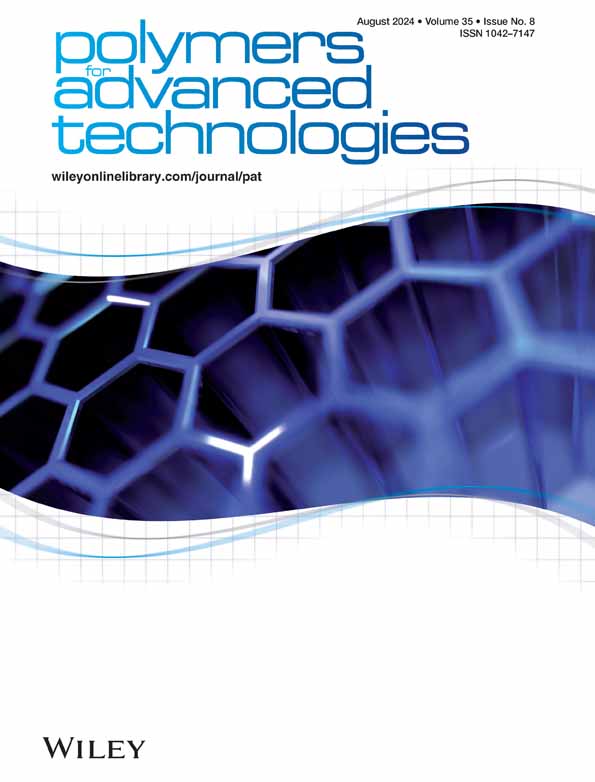β‐Carotene‐reinforced Poly(methyl methacrylate): A step forward in bioactive bone cements
IF 3.4
4区 工程技术
Q2 POLYMER SCIENCE
引用次数: 0
Abstract
By making use of the outstanding osteoinductive effects of β‐carotene, in this innovative research, we investigate the potential for application of β‐carotene‐reinforced PMMA resins. Different amounts of β‐carotene, from 0% to 5%, have been mixed with standard bone cements and characterized by various spectroscopic and microscopic techniques before testing with KUSA‐A1 murine mesenchymal cells. In vitro results showed that not only the amount of bone produced by the cells on the composite is comparable if not superior to modern bioglasses but also both adhesion and cellular proliferation are strongly promoted by the presence of β‐carotene. The increased biological properties came at the price of a small loss in elastic modulus, but it was observed that the presence of β‐carotene leads to an increase of ultimate strength, reaching an increase of about 30% at a concentration of about 2.5%. The enhanced bioactivity and mechanical strength make β‐carotene‐reinforced PMMA a promising, innovative material for biomedical applications.β-胡萝卜素增强聚甲基丙烯酸甲酯:生物活性骨水泥向前迈进了一步
在这项创新研究中,我们利用β-胡萝卜素突出的骨诱导作用,研究了β-胡萝卜素增强 PMMA 树脂的应用潜力。在标准骨水泥中混合了从 0% 到 5% 的不同量的β-胡萝卜素,并在用 KUSA-A1 小鼠间充质细胞进行测试之前通过各种光谱和显微技术对其进行了表征。体外试验结果表明,细胞在复合材料上产生的骨量不仅可与现代生物玻璃相媲美,甚至更胜一筹,而且β-胡萝卜素的存在还能极大地促进粘附性和细胞增殖。生物特性的提高是以弹性模量的少量损失为代价的,但据观察,β-胡萝卜素的存在导致了极限强度的提高,在浓度约为 2.5%时,极限强度提高了约 30%。增强的生物活性和机械强度使β-胡萝卜素增强 PMMA 成为一种很有前途的生物医学应用创新材料。
本文章由计算机程序翻译,如有差异,请以英文原文为准。
求助全文
约1分钟内获得全文
求助全文
来源期刊

Polymers for Advanced Technologies
工程技术-高分子科学
CiteScore
6.20
自引率
5.90%
发文量
337
审稿时长
2.1 months
期刊介绍:
Polymers for Advanced Technologies is published in response to recent significant changes in the patterns of materials research and development. Worldwide attention has been focused on the critical importance of materials in the creation of new devices and systems. It is now recognized that materials are often the limiting factor in bringing a new technical concept to fruition and that polymers are often the materials of choice in these demanding applications. A significant portion of the polymer research ongoing in the world is directly or indirectly related to the solution of complex, interdisciplinary problems whose successful resolution is necessary for achievement of broad system objectives.
Polymers for Advanced Technologies is focused to the interest of scientists and engineers from academia and industry who are participating in these new areas of polymer research and development. It is the intent of this journal to impact the polymer related advanced technologies to meet the challenge of the twenty-first century.
Polymers for Advanced Technologies aims at encouraging innovation, invention, imagination and creativity by providing a broad interdisciplinary platform for the presentation of new research and development concepts, theories and results which reflect the changing image and pace of modern polymer science and technology.
Polymers for Advanced Technologies aims at becoming the central organ of the new multi-disciplinary polymer oriented materials science of the highest scientific standards. It will publish original research papers on finished studies; communications limited to five typewritten pages plus three illustrations, containing experimental details; review articles of up to 40 pages; letters to the editor and book reviews. Review articles will normally be published by invitation. The Editor-in-Chief welcomes suggestions for reviews.
 求助内容:
求助内容: 应助结果提醒方式:
应助结果提醒方式:


